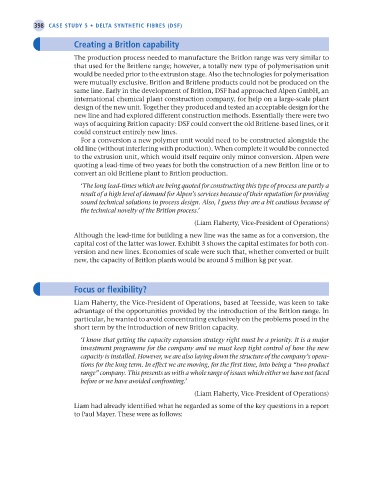Page 423 - Operations Strategy
P. 423
398 case study 5 • delta synthetic Fibres (dsF)
creating a britlon capability
The production process needed to manufacture the Britlon range was very similar to
that used for the Britlene range; however, a totally new type of polymerisation unit
would be needed prior to the extrusion stage. Also the technologies for polymerisation
were mutually exclusive. Britlon and Britlene products could not be produced on the
same line. Early in the development of Britlon, DSF had approached Alpen GmbH, an
international chemical plant construction company, for help on a large-scale plant
design of the new unit. Together they produced and tested an acceptable design for the
new line and had explored different construction methods. Essentially there were two
ways of acquiring Britlon capacity: DSF could convert the old Britlene-based lines, or it
could construct entirely new lines.
For a conversion a new polymer unit would need to be constructed alongside the
old line (without interfering with production). When complete it would be connected
to the extrusion unit, which would itself require only minor conversion. Alpen were
quoting a lead-time of two years for both the construction of a new Britlon line or to
convert an old Britlene plant to Britlon production.
‘The long lead-times which are being quoted for constructing this type of process are partly a
result of a high level of demand for Alpen’s services because of their reputation for providing
sound technical solutions in process design. Also, I guess they are a bit cautious because of
the technical novelty of the Britlon process.’
(Liam Flaherty, Vice-President of Operations)
Although the lead-time for building a new line was the same as for a conversion, the
capital cost of the latter was lower. Exhibit 3 shows the capital estimates for both con-
version and new lines. Economies of scale were such that, whether converted or built
new, the capacity of Britlon plants would be around 5 million kg per year.
Focus or flexibility?
Liam Flaherty, the Vice-President of Operations, based at Teesside, was keen to take
advantage of the opportunities provided by the introduction of the Britlon range. In
particular, he wanted to avoid concentrating exclusively on the problems posed in the
short term by the introduction of new Britlon capacity.
‘I know that getting the capacity expansion strategy right must be a priority. It is a major
investment programme for the company and we must keep tight control of how the new
capacity is installed. However, we are also laying down the structure of the company’s opera-
tions for the long term. In effect we are moving, for the first time, into being a “two product
range” company. This presents us with a whole range of issues which either we have not faced
before or we have avoided confronting.’
(Liam Flaherty, Vice-President of Operations)
Liam had already identified what he regarded as some of the key questions in a report
to Paul Mayer. These were as follows:
Z05 Operations Strategy 62492.indd 398 02/03/2017 13:42

